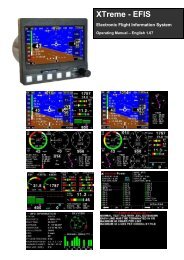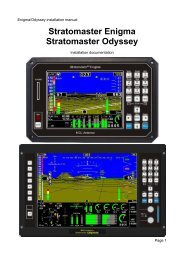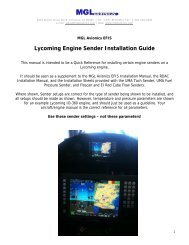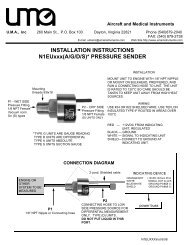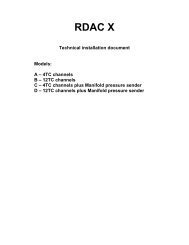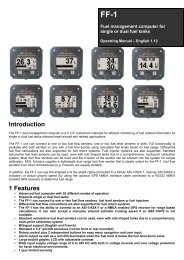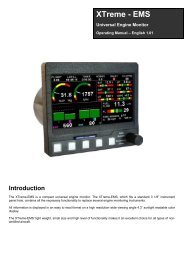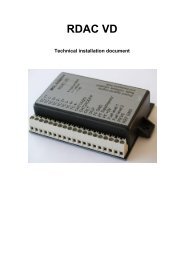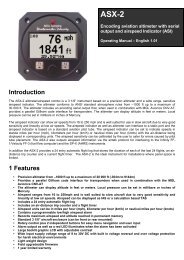You also want an ePaper? Increase the reach of your titles
YUMPU automatically turns print PDFs into web optimized ePapers that Google loves.
<strong>ASX</strong>-1 Operating <strong>Manual</strong> Page 64.5 Altitude SetupMove the highlight over this menu item and press the rotary button to return to the main menu.Select if you want your altitude readout in feet (ft) or meters (m).Select if you want your local pressure readout in millibars (mB) or inches of Mercury (“Hg).Select whether you want the altitude display on the top or on the bottom of the main display.4.6 Airspeed SetupAll the airspeed parameters can be setup here.Move the highlight over the “DONE” menu item and press the rotary button to return to the mainmenu.This setup allows your instrument to measure the zero airspeed reading of theairspeed sensor and set a calibration value internally for this. This is equivalentto some mechanical airspeed indicators that have an adjustment to set theneedle to zero when the aircraft is not moving. You would use this functionoccasionally if you see an airspeed reading when the aircraft is at rest. Thismay be caused by aging of the built in pressure sensor or related electronics. When you perform this function, make surethat no wind is blowing into the pitot tube as this would result in an incorrect internal calibration.Pressing the F1 key will zero the airspeed sensor.Enter whether you want the airspeed to display true airspeed (TAS) or indicated airspeed (IAS).Please see section 6 below for more information on true airspeed (TAS).
<strong>ASX</strong>-1 Operating <strong>Manual</strong> Page 8Move the highlight over this menu item and press the rotary button to return to the main menu.On the back of the <strong>ASX</strong>-1 you will find the calibration number that has been determined to result inthe most accurate reading of your altimeter. This is the value that should be entered here. Shouldyou have access to an accurate reference you may use this function to calibrate your altimeter.Before you do this, ensure that you have your local pressure set to coincide with a calibrated andcertified reference. Your altimeter has been calibrated by the factory to an accuracy of +/- one mBor approximately +/- 30 ft (10m).This function is used to calibrate your airspeed indicator. During the factory calibration a factor hasbeen determined and entered here that will give you accurate airspeed provided your pitot tube isnot influenced by pressure effects caused by airflow around your airframe. The calibration works in% of the reading and you can increase or decrease the reading if required to help cancel out underor over reading of the airspeed indicator on your aircraft. The original calibration factor has beenwritten onto the back of your instrument.5 Altitude EncoderTo use the <strong>ASX</strong>-1 as an encoding altimeter an Airtalk to parallel Gillham code output encoder such as the <strong>MGL</strong> <strong>Avionics</strong>CNV-AT must be used. This converter takes the Airtalk serial string that is outputted by the <strong>ASX</strong>-1 and converts it to aparallel Gillham code suitable for aircraft transponders. Please see the CNV-AT operating manual for more information.6 True airspeed (TAS)TAS is indicated airspeed corrected for air density. As air density decreases with altitude, an airspeed indicator will under readat altitude. This error can be appreciable, for example at an altitude of 5 000 ft (1 524 m) errors of 5% to 10% are possibledepending on local weather and temperature conditions. As you increase the altitude the error gets larger quickly. Setting yourinstrument to read TAS will correct for this error based on the pressure altitude reading, taking your current QNH setting intoaccount. The result of this is an airspeed reading that can be as accurate as 1%, depending mainly on the errors introduced bythe airflow around your aircraft and pitot tube.How is TAS calculated? Often pilots ignore the effect of temperature and only take altitude into account when convertingASI to TAS. For practical purposes this is quite accurate and gives a good reflection on your true airspeed. Keeping inmind that ASI measurement is subject to errors caused by airflow around your aircraft, there seems little point in takingthis calculation to absolute resolution. Again, we have decided to use a formulae often used by pilots. This way theinstrument reading will agree with what pilots are used to.Based on Worthington’s 13th edition page 349:Add 1.75% of indicated airspeed (IAS) per 1000 ft (304.9 m) increase in altitude above sea level.We assume here that IAS = RAS (rectified air speed).Warning when using TAS: You aircraft’s stall, rotation and approach speeds are based on sea-level ASIindication. Should you use TAS indication at altitude you must correct for the reduced ambient pressure effectson the control and flight surfaces of your aircraft. Should you fail to do so you will endanger your flight by flyingto slowly for prevailing conditions. Always use the ASI indication to determine your rotation or approachspeeds.
<strong>ASX</strong>-1 Operating <strong>Manual</strong> Page 97 Loading factory default settingsPressing and holding the F1 and F2 simultaneously on power up will cause the <strong>ASX</strong>-1 to load preprogrammed factorydefault settings. The following screen will be displayed:8 Operating the alarmsIf the alarm is activated, the corresponding item on the display will flash. At the same time the externally available alarmswitch will close. The switch will remain closed until any button is pressed to acknowledge the alarm or until thecondition(s) that activated the alarm no longer exist. The alarm output can be used to switch an external alarm indicator.The external alarm switch is an open collector transistor switch to ground with a maximum rating of 0.5A DC. It is possibleto wire the alarm contacts of several Stratomaster instruments in parallel should this be desired. To avoid false activationof the alarms, the alarm function is only active 10 seconds after the instrument has powered up.9 CleaningThe unit should not be cleaned with any abrasive substances. The screen is very sensitive to certain cleaning materialsand should only be cleaned using a clean, damp cloth.Warning: The <strong>ASX</strong>-1 is not waterproof, serious damage could occur if the unit is exposed towater and/or spray jets.10 <strong>ASX</strong>-1 SpecificationsOperating Temperature Range-10ºC to 50ºC (14ºF to 122ºF)Storage Temperature Range-20ºC to 80ºC (-4ºF to 176ºF)Humidity
<strong>ASX</strong>-1 Operating <strong>Manual</strong> Page 1011 InstallationConnect the static port to a suitable static air pressure line. If you have a slow aircraft or an aircraft were the internal cabinpressure does not change during flight and is equivalent to the outside air pressure you may find that it is not required toconnect a static port. For installations in typical ultralight aircraft pods, be aware of possible pressure changes inside thepod during flight caused by ram air or suction effects. This may lead to a false indication of altitude and/or airspeed. Oftenthese effects are dependent on the current angle of attack of the airflow around your pod. You will need to install asuitable static port in these cases. Connect your pitot tube to the “pressure port”. Pitot tubes are found in a large variety atyour aircraft parts shop, in mail order catalogs or you can make your own. Contrary to popular belief, pitot tubes are notcarefully designed and calibrated, but are simple orifices or tubes that get pointed in the direction that you are flying. Theforward movement of the aircraft causes air to dam inside the pitot tube. This increases the pressure inside the tube. Mostsmall aircraft such as ultralights or microlights do not require a connection to a static port. In these cases, simply leave thestatic port open. Ensure however that the static port does not receive pressurized air due to the forward movement of theaircraft. Be especially critical of your pod or panel if you do not use a static port. Any build up of a pressure differential dueto ram air or suction can lead to large errors of the indicated airspeed. Static ports are usually mounted at a strategicposition on the rear side of the aircraft fuselage for faster, pressurized aircraft. Suitable pitot tubes can be made from ashort piece of hollow aluminium or copper piping. Length and diameter are not important. Ensure that the front of the pitottube has a suitable chamfer if you use thick walled tubing or you may introduce a speed reading error if you have a fasteraircraft.Example cross-section of thick walled pitot tube.Suitable connection hose for both pitot tube and static port can be obtained from a hardware store or even a pet shop.Good quality tubing is often used for fish tanks and it has just the right diameter. Please note that this kind of tubing is notadvised for pressurized aircraft. In this case you would need to obtain aircraft grade tubing of suitable diameter. Youwould also have to use hose clamps to fasten the hose onto the <strong>ASX</strong>-1 pitot and static ports. The <strong>ASX</strong>-1 allows you tocalibrate the airspeed reading. This is done in the “Calibrate” menu item. The main reason for this is to be able to removeerrors introduced due to the airflow around your aircraft which may have an effect of your pitot tube pressure.11.1 <strong>ASX</strong>-1 DB9 Cable connectionsDB 9 Pin Color Function1 Black Ground4 RCA(Innercable)Airtalk communicationUsed for firmware upgrading andinterfacing to the FF-1/SP-X (Airtalk speedmessage) or the CNV-AT (Airtalk toparallel Gillham code output encoder)6 Red 8-30Vdc power9 White Alarm Output
<strong>ASX</strong>-1 Operating <strong>Manual</strong> Page 1111.2 Connection DiagramConnect static port to suitable static line on the aircraft. Note: Leaving this port unconnected may lead to airspeed andaltitude errors as cabin pressure changes due to airflow or other factors. Connect the pressure port to a pitot tube. Thelocation of the pitot tube should be chosen so it is exposed to clean, undisturbed airflow at the same speed as the aircraftif flying. Small errors related to location may be calibrated out using the ASI calibration function.The use of an external 1A fuse is recommended. Connect the supply terminals to your aircrafts power supply. The ASI-1can be used on both 12V and 24V without the use of any pre-regulators. Ensure that the supply voltage will not dropbelow 8V during operation as this may result in incorrect voltage and or current readings.11.3 Pressure Port DimensionsABCDInchesMillimetersMin Max Min Max0.248 0.278 6.30 7.060.420 0.440 10.67 11.180.182 0.194 4.62 4.930.310 0.330 7.87 8.38
<strong>ASX</strong>-1 Operating <strong>Manual</strong> Page 1212 WarrantyThis product carries a warranty for a period of one year from date of purchase against faulty workmanship or defectivematerials, provided there is no evidence that the unit has been mishandled or misused. Warranty is limited to thereplacement of faulty components and includes the cost of labour. Shipping costs are for the account of the purchaser.Damage as a result of applying excessive pressure to the pressure ports are excluded from warranty.Note: Product warranty excludes damages caused by unprotected, unsuitable or incorrectly wiredelectrical supplies and or sensors, and damage caused by inductive loads.13 DisclaimerOperation of this instrument is the sole responsibility of the purchaser of the unit. The user must make themselves familiarwith the operation of this instrument and the effect of any possible failure or malfunction.This instrument is not certified by the FAA. Fitting of this instrument to certified aircraft is subject to the rules andconditions pertaining to such in your country. Please check with your local aviation authorities if in doubt. This instrumentis intended for ultralight, microlight, homebuilt and experimental aircraft. Operation of this instrument is the soleresponsibility of the pilot in command (PIC) of the aircraft. This person must be proficient and carry a valid and relevantpilot’s license. This person has to make themselves familiar with the operation of this instrument and the effect of anypossible failure or malfunction. Under no circumstances does the manufacturer condone usage of this instrument for IFRflights.The manufacturer reserves the right to alter any specification without notice.Other instruments in the Stratomaster Infinity seriesALT-1 Precision encoding altimeter and vertical speed indicatorALT-2 Precision encoding altimeter and vertical speed indicator with a serial RS232transponder outputASI-1 Airspeed indicator (ASI) with automatic flight log<strong>ASX</strong>-1 Encoding aviation altimeter with serial output and airspeed indicator (ASI)AV-1 Artificial horizon and magnetic compass indicatorBAT-1 Battery voltage and current monitorE-3 Universal engine monitorFF-1 Fuel Computer (single or dual fuel tanks)GF-1 +-10G tilt compensated dual range G-force meterMAP-1 Manifold pressure and RPM IndicatorRV-1 Universal engine RPM and rotor RPM IndicatorRV-2 Universal turbine RPM / RPM factor displayRTC-2 Aviation real time clock (RTC) and outside air temperature (OAT) displayTC-1 4-Channel thermocouple indicatorTP-1 Universal temperature and pressure gauge



